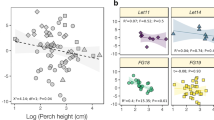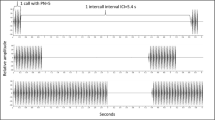Summary
In the previous study (Wilczynski et al. 1984) we found that neurons in the auditory nerve of female spring peepers (Hyla crucifer) are tuned to frequencies in the male advertisement call, whereas auditory units in male peepers are mismatched in spectral sensitivity to their call. We investigated, in the present report, behavioral consequences of this sexual dimorphism in auditory sensitivity. Call amplitude, rate of call attenuation with environmental transmission, and the amplitude of ambient noise were measured and used to compute the active space of this signal for males and females. The effect of calling height upon active space was considered. Measurements of active space were compared with intermale distances within breeding choruses.
Results indicate that active space of the advertisement call for females is as much as 6 times greater than that for males, and varies directly with the height above ground from which males call. Observed maximum intermale distances correspond closely to the active space of the call for this sex. This suggests that males space themselves so that the amplitude of a neighbor's calls approximates their auditory neural threshold to call frequencies. By this proximal mechanism, peepers maximize intermale distance but ensure that they remain within a chorus.
Similar content being viewed by others
Abbreviations
- dB SPL :
-
decibels sound pressure levelre: 20 μPa
References
Altmann SA (1959) Field observations on a howling monkey society. J Mammal 40:317–330
Awbrey ET (1978) Social interaction among chorusing Pacific tree frogs,Hyla regilla. Copeia 1978:208–214
Brenowitz EA (1982) The active space of red-winged blackbird song. J Comp Physiol 147:511–522
Campbell DJ, Shipp E (1979) Regulation of spatial pattern in populations of the field cricketTeleogryllus commodus (Walker). Z Tierpsychol 51:260–268
Doolan JM, MacNally RC (1981) Spatial dynamics and breeding ecology in the cicadaCytosoma saundersii: the interaction between distributions of resources and intraspecific behavior. J Anim Ecol 50:925–940
Emlen ST (1976) Lek organization and mating strategies in the bullfrog. Behav Ecol Sociobiol 1:283–313
Fellers GM (1979) Aggression, territoriality, and mating behavior in North American treefrogs. Anim Behav 27:107–119
Gerhardt HC (1975) Sound pressure levels and radiation patterns of the vocalizations of some North American frogs and toads. J Comp Physiol 102:1–12
Griffin DR, Hopkins CD (1974) Sounds audible to migrating birds. Anim Behav 22:672–678
Hamilton WD (1971) Geometry for the selfish herd. J Theor Biol 31:295–311
Loftus-Hills JJ, Littlejohn MJ (1971) Mating-call sound intensities of anuran amphibians. J Acoust Soc Am 49:1327–1329
Marler P (1972) Vocalizations of East African monkeys II: Black and white colobus. Behaviour 42:175–197
Marten K, Marler P (1977) Sound transmission and its significance for animal vocalization I. Temperate habitats. Behav Ecol Sociobiol 2:271–290
Marten K, Quine D, Marler P (1977) Sound transmission and its significance for animal vocalization II. Tropical forest habitats. Behav Ecol Sociobiol 2:291–302
Morton ES (1975) Ecological sources of selection on avian sounds. Am Nat 108:17–34
Narins PM, Hurley DD (1982) The relationship between call intensity and function in the Puerto Rican coqui (Anura: Leptodactylidae). Herpetologica 38:287–295
Passmore NI, Telford SR (1981) The effect of chorus organization on mate localization in the painted reed frog (Hyperolius marmoratus). Behav Ecol Sociobiol 9:291–293
Robertson JGM (1984) Acoustic spacing by breeding males ofUperoleia rugosa (Anura: Leptodactylidae). Z Tierpsychol 64:283–297
Rosen M, Lemon LE (1974) The vocal behavior of spring peepers,Hyla crucifer. Copeia 1974:940–950
Ryan MJ (1983) Sexual selection and communication in a neotropical frog,Physalaemus pustulosus. Evolution 37:261–272
Ryan MJ, Tuttle MD, Taft LK (1981) The costs and benefits of frog chorusing behavior. Behav Ecol Sociobiol 8:273–278
Waser PM, Waser MS (1977) Experimental studies of primate vocalization: specializations for long distance propagation. Z Tierpsychol 43:239–263
Wells KD (1977) The social behavior of anuran amphibians. Anim Behav 25:666–693
Whitney CL, Krebs JR (1975) Spacing and calling in Pacific tree frogs,Hyla regilla. Can J Zool 53:1519–1527
Wilczynski W, Zakon H, Brenowitz EA (1983) A sex difference in basilar papilla tuning in theHyla crucifer auditory system and its behavioral significance. Soc Neurosci Abstr 9:531
Wilczynski W, Zakon HH, Brenowitz EA (1984) Acoustic communication in spring peepers: Call characteristics and neurophysiological aspects. J Comp Physiol A 155:577–584
Wiley RH, Richards DG (1978) Physical constraints on acoustic communication in the atmosphere: implications for the evolution of animal vocalizations. Behav Ecol Sociobiol 3:69–94
Wiley RH, Richards DG (1982) Adaptations for acoustic communication in birds: sound transmission and signal detection. In: Kroodsma DE, Miller EH (eds) Acoustic communication in birds. Production, perception, and design features of sound, vol 1. Academic Press, New York, pp 132–181
Author information
Authors and Affiliations
Rights and permissions
About this article
Cite this article
Brenowitz, E.A., Wilczynski, W. & Zakon, H.H. Acoustic communication in spring peepers. J. Comp. Physiol. 155, 585–592 (1984). https://doi.org/10.1007/BF00610844
Accepted:
Issue Date:
DOI: https://doi.org/10.1007/BF00610844




